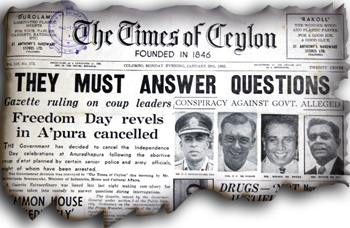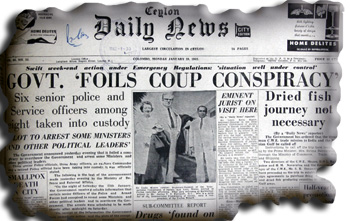It was exactly 50 years ago. A coup d’etat by military and police high-ups with a senior civil servant, was planned to take place on the night of January 27, 1962. The conspirators believed the politicians were ruining the country through maladministration. Mission ‘Operation Holdfast’ was expected to be accomplished within a few hours.
Many perceived the botched attempt as a last ditch effort by the military elite to safeguard their eroding position. They were propelled by an overriding feeling of loss of power and the status that they enjoyed. Others viewed it as the result of rapid Sinhalisation of all parts of the government paying scant respect to the interests and aspirations of other major non-Sinhala speaking citizens. Other contributory factors were the campaign led by N.Q. Dias, the Defence Secretary championing the ‘Sinhala-Buddhist’ cause and the powerful Minister, Felix Dias Bandaranaike’s speech in early January, in support of an authoritarian system of government.
 |
 |
| Pages from history: Headlines of some newspapers of the day |
The world’s first woman Prime Minister Sirimavo Bandaranaike, who continued her slain husband’s language and socialist policies was considered by them as someone weak, inexperienced and unfit to govern, and therefore to be replaced in the larger interest. According to plans, the PM was to be arrested on her way to Kataragama.
Bradman Weerakoon, in his ‘Rendering unto Caesar’, says ( Page 109), ‘They planned. .assuming that Sirimavo would be travelling that night , if she had. . the coup may well have succeeded’. As per blueprint, at 10 p.m. senior DIG, C.C. Dissanayake was to issue a “Take post” order. Col. Maurice de Mel was to be at Army headquarters; Col. F.C. de Saram, the former Ceylon cricket captain was to position himself at “Temple Trees” with Dissanayake at “Queen’s House” and ex- DIG, Sydney de Zoysa co-ordinating Army and Police operations from field force HQs. ASP Johnpillai was to clear all main roads and strategically important highways of traffic, while Douglas Liyanage, CCS, played a silent role. Seizure of Colombo city and cordoning it off was deemed important to resist a potential counter-strike.
Senior ministers including Felix Dias Bandaranaike, officials, N.Q. Dias, DIG-CID S.A. Dissanayake (Jingle) who was twin brother of C.C. Dissanayake (Jungle), acting Navy chief and the SP-CID John Attygalle were to be detained in an underground bunker at the armory.
The Central Telephone and Telegraph Exchange was to be shut down; Police headquarters, (CID) offices, Times of Ceylon, Lake House and the only electronic communication institute, “Radio Ceylon” were to be taken over by 11 p.m.
Army commander Maj-Gen. Gerard Wijeykoon, Acting Navy commander Rajan Kadirgamar, Air Force chief, John F. Barker and IGP M.W.F. Abeykoon were entirely in the dark about the conspiracy. Once the coup was accomplished the leaders were to meet at “Queen’s House” and request the Governor-General Sir Oliver Goonetilleke to dissolve Parliament, suspend the constitution and take direct authority.
The initial plan however went awry because of a sudden cancellation in Mrs. Bandaranaike’s itinerary. The conspirators were rattled fearing that Mrs. Bandaranaike had come to know of the coup. A contingency plan was made where Lt. Col Willie Abraham was to move into “Temple Trees”.
It was on January 27, during their regular “morning walks” on Galle Face Green that Dissanayake revealed to his subordinate, Stanley Senanayake SP some details of the coup, inviting him to join. However Senanayake was not in favour and that afternoon he declined the offer. Realising that he had misjudged Senanayake, Dissanayake kept contemplating. There were misgivings among the core group comprising De Saram, the De Mel brothers, Royce and Morris, De Zoysa and Dissanayake about the feasibility of going ahead as planned. Stanley Senanayake wrestling with his conscience for hours told his wife Maya, daughter of P. de S. Kularatne, a former Principal of Ananda College who was now a Parliamentarian, about the planned conspiracy. She spoke to her father and a shocked Kularatne informed the IGP and Felix Dias Bandaranaike of the plot.
The conspirators sensing something was amiss, met at Wellawatte around 9 p.m. and decided to call off the plan and dispersed to their homes only to be arrested within a few hours. They did not have plans for retaining power. According to their thinking, the first phase would be a junta of only coup leaders running the show, the second a council of ex-Prime Ministers, coup leaders and the Governor General and then back to democracy under a new constitution. Whether they would have stuck to this plan if the coup had succeeded will remain a big question mark. After a protracted trial, 11 out of 24 were found guilty, but subsequently discharged by the Privy Council in UK, which ruled in their favour on issues of technicality.
Minister Felix Dias Bandaranaike in a statement to Parliament on February 13 revealed that a police officer in his statement had said that one of the leaders told him about the involvement of Sir John Kotelawale and Dudley Senanayake. Dudley rose at the end of the speech and vehemently denied any involvement and even volunteered to face an inquiry. Everybody including some government Parliamentarians pooh-poohed the idea as a fabrication by Felix who directly handled investigations.
Journalist H. Ludowyk, a close relative of a suspect, in a manuscript named ‘The story of a coup d’e-tat’, addressed to J.R. Jayewardene, (Manuscripts –321 JRJ Centre) states that, ‘Felix himself an interested party,. . unethically using judicial powers, investigated suspects in secret. . . , wrongfully detained, and ill-treated to destroy their integrity and morale for the purpose of extorting confessions of guilt. . ..’ The Criminal Law Special Provisions Act no. 1 of 1962, passed with retrospective effect, introducing a Trial-at-bar with three SC judges, also made Draconian provisions in accepting a statement by a suspect as valid evidence against any of the suspects indicted. However, J.R. Jayewardene, responding to interviews by Professors Howard Wriggins and K. M. de Silva, the authors of his biography, stated, (The first solid evidence), that at a meeting with Sir John on April 13, 1966, he was shocked to learn for the first time from the latter that both Sir John and Dudley had been involved in the planned attempt.
The JRJ biography refers to Dudley, (vol. ii- page 114),
‘Yet we have uncovered very solid evidence of his involvement in the coup. Was he driven by a personal animosity against Sirimavo so deep-rooted that he would countenance any measures to bring down her government ? Or was it that, in his view, the government incompetent in handling the country’s affairs. …. .damaged the economy, relations between Sinhalese and minorities, that he would encourage a coup once he came to know that it was being planned ? Or did he believe that Felix Dias was planning a coup of his own in association of men like N. Q. Dias, and that he would look upon this military coup as a genuine counter-coup, a very necessary measure of preventive action? He carried this secret with him to the grave and so we will never know.’
All the coup leaders took great pains at every stage, before and after the trial not to comment on the alleged involvement of Dudley or Sir John. Governor General, Sir Oliver’s reputation however suffered with his removal from office. JR kept mum without making an open accusation against Dudley who was then his Prime Minister, but he told Esmond Wickremesinghe (father of Opposition Leader Ranil ), Lake House boss and his (JR’s) political ally, who persuaded Sir John to make a written statement on January 11, 1968. (A copy of which is preserved at the J.R.Jayewardene Centre).
Esmond was anxious that the old man put it on record before he died. A note by Esmond to JR dated March 10, 1984, states that Sir John mentioned the involvement of Dudley, to Sirimavo in the company of Maithripala Senanayake, at a dinner in late 1969.
The two professors, who interviewed Sir John on September 15, 1979, write (page 116, vol ii) ‘He explained how the coup leaders had met him . . . far from discouraging them, asked them to be extremely cautious in what they were doing. . . . and told them to get the support of Dudley and Sir Oliver,. . . he stated that the meeting to finalize the coup took place at Kitulwatta stores, an abandoned plumbago store house in Borella, owned by him and the next at his Kandawala residence, on 26 January, both chaired by Dudley’.
The two professors, in 1979, approached coup leaders F. C. de Saram, D. Liyanage and Royce de Mel for interviews, all three declined, but after Horowitz’s work, the ‘Coup Theories and Officer Motives. . .’ that included interviews by most of them was published, de Mel broke his silence and divulged his knowledge of Sir John’s and Dudley’s alleged roles. Explaining his meetings with both at the plumbago godown in Borella and at Kandawala, he said, Dudley was billed to address the ‘Junta’ shortly after midnight on January 27, at the Independence Hall, Torrington Square, after the success of the coup.
That as history records did not happen. |



